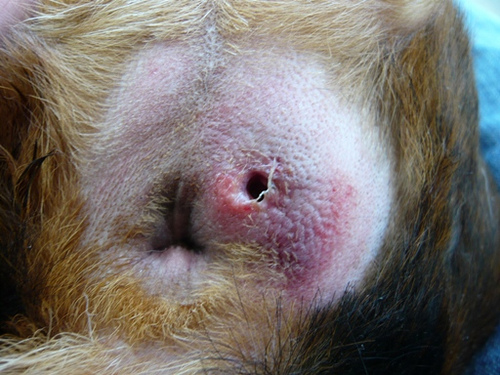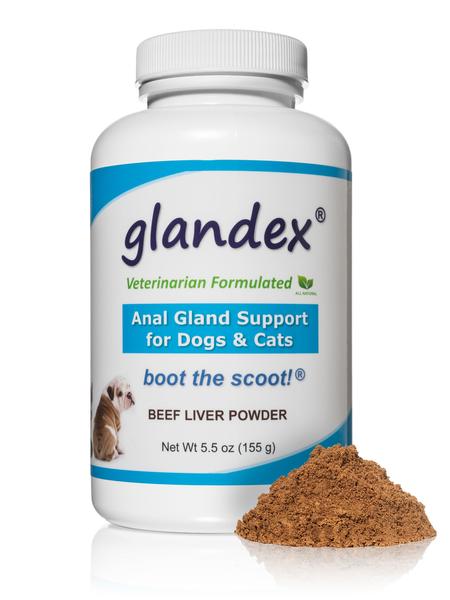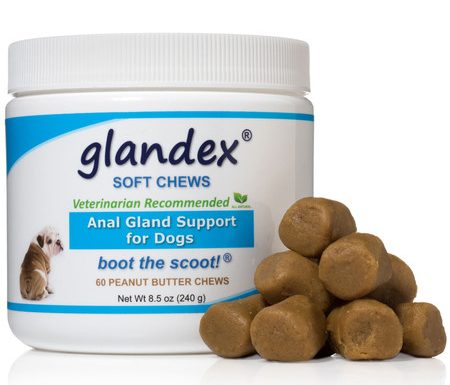A few days ago I was able to catch up with an emergency medicine colleague after she had finished working a hellish shift. In our conversation, she told me she had treated three patients with abscessed anal glands during her shift. I guess things really do come in threes! Her stories gave birth to this week’s post in which I share some tidbits about anal gland abscesses. I’ve previously provided information about anal gland impaction in our fur babies. Anal gland abscesses occur when impaction at this site goes to hell in a handbasket. Happy reading!
Anal glands – What are they?
The anal glands are two sacs inside the anus of dogs and cats located at the 4 o’clock and 8 o’clock positions. The anal glands lie between the internal and external anal sphincters, the muscles that keep feces inside the rectum until a pet defecates. These sacs normally fill with a smelly substance that can be thick and dark, clear and watery, and even chunky at times. All of these consistencies are normal. Currently the only discharge considered truly abnormal is one containing blood. A small tube (called a duct) that opens just inside the anus connects each sac to the outside.
Anal gland abscesses – What do they look like?
Under normal circumstances, pets express their anal glands during routine defecation without incident. For this reason, routine expression of anal glands by people is not recommended. Some patients can’t empty their anal glands normally, resulting in impaction. One incident of scooting is not necessarily an issue. However, repeated scooting should prompt veterinary examination as soon as possible. Persistent scooting is, perhaps, the most common clinical sign observed in pets with impacted anal sacs.
As I discussed in a previous post about anal gland impaction, other potential clinical signs include:
- Excessive licking the anus
- Difficulty defecating
- Abnormally formed feces
- Blood on the surface of feces and/or around the anus
- Vocalization during defecation
Patients with anal gland abscesses may have an abnormal opening(s) to one or both sides of their rectum. This hole(s) represents where the abscess has ruptured, and infected discharge is draining. If an abscess has not yet ruptured, the affected pet will have a variably-sized, warm, painful swelling near its rectum.

Anal gland abscesses – How are they treated?
Veterinarians may treat anal gland abscesses medically or surgically depending on whether the anal gland has ruptured or not. For unruptured abscesses, a veterinarian will need to perform minor surgery under general anesthesia. During surgery, the doctor will open the abscessed gland to facilitate drainage of the infected fluid. Often abscesses are already ruptured by the time the pet is evaluated by a veterinarian. For these patients, the medical team will thoroughly lavage (rinse) the anal sac to clear away infected material. All patients with anal gland abscesses should receive an antibiotic (typically for 1 week without complications). For cats, the doctor may administer an injectable antibiotic (cefovecin/Convenia®) labelled for certain skin abscesses that provides coverage for approximately seven days.
Pets with recurrent anal gland abscesses benefit from surgical removal of the affected sacs. Removal of the anal glands (called a sacculectomy) is a specialized surgery. Some primary veterinarians are comfortable performing the operation. Although rare, temporary and permanent nerve damage can happen, resulting in lack of bowel control. Thus, pet parents should consider partnering with a board-certified veterinary surgeon who has extensive training and experience performing this delicate procedure.
Anal gland abscesses – Can I prevent them?
Perhaps the most important step pet parents can take help reduce the likelihood of their pets developing anal gland problems, including abscesses, is to not allow routine expression of anal glands. Expression of the anal glands is common practice by groomers. Don’t let them do it! Why? The tubes that connects each anal gland to the anus (called ducts), as well as the resultant openings in the rectal wall (called puncta), are very narrow. The current theory is inappropriate and/or repeated expression of anal sacs creates meaningful inflammation in and around them. This inflammation subsequently obstructs the important ducts and/or puncti that can lead to serious issues like the formation of abscesses.
Overweight and obese animals tend to have recurrent issues because they are not able to empty their anal glands as efficiently as ideal weight animals. Therefore, pet parents should keep their fur babies in a proper body condition to help reduce the incidence of anal gland impaction. There is some evidence environmental allergies and/or food hypersensitivities exacerbate anal gland issues. Accordingly, partnering with a board-certified veterinary dermatologist may be uniquely helpful to identify an underlying issue that predisposes a patient to anal sac impaction.
Recently I’ve become a fan of a unique, all-natural product called Glandex®.
Glandex® – Why might it help?
This American-made product contains high-quality fiber, omega-3 fatty acids, digestive enzymes, and probiotics designed to promote anal gland health. Active ingredients include:
- Pumpkin seed
- Apple pectin
- Bromelain
- Quercetin dehydrate
- Lactobacillus acidophilus
Apple pectin is a complex carbohydrate, specifically a soluble fiber, found in the walls of plant cells. Pumpkin seeds are another high quality source of fiber. Bromelain is a mixture of enzymes found in pineapples (Ananas comosus) that help digest proteins. Pineapple has been used for centuries in Central and South America to treat indigestion and reduce inflammation. Quercetin is an antioxidant found in many fruits, vegetable, leaves, and grains.
This unique combination of all-natural ingredients helps promote anal gland heath by increasing the bulk and firmness of a pet’s feces. Remember pet’s express their anal glands normally during defecation. The added bulk provided by Glandex® helps facilitate normal emptying of your fur baby’s anal glands. The natural anti-inflammatory and probiotic ingredients further support a healthy digestive tract and subsequently healthy anal sacs.
Anal gland problems are some of the most common reasons pet parents bring their fur babies to veterinarians for examination. As a clinician, a product like Glandex that is formulated with safe and effective all-natural ingredients affords me a non-drug option to promote anal gland health in my patients. -cgb”
Glandex® is available as naturally flavored (100% beef liver) powder pet parents give with their pet’s food once a day used label instructions. The best way to give Glandex® is to sprinkle it directly on top of the pet’s dry food. Pet parent can also mix this product with a small amount of warm water to create a tasty gravy your pet will love! For dogs only, Glandex® is also available as a tasty peanut butter flavored chew treat with the same all-natural ingredients as the powder.
The take-away message about anal gland abscesses…
The anal glands are normal structures just inside the rectum of our dogs and cats. During defecation, pets empty these structures of their secretions. Occasionally, anal glands become severely impacted, resulting in the formation of an abscess. When this occurs, veterinarians will need to perform surgery, thoroughly clean/flush the affected gland, and treat with an antibiotic. Veterinarians do not recommend routine expression of anal glands. Several interventions are available, including maintaining a healthy body weight and all-natural supplements, to help reduce the likelihood of anal gland problems.
Wishing you wet-nosed kisses,
cgb
PET PARENTS – For a 10% discount of Glandex® products, please use promo code CriticalCareDVM and click here.







